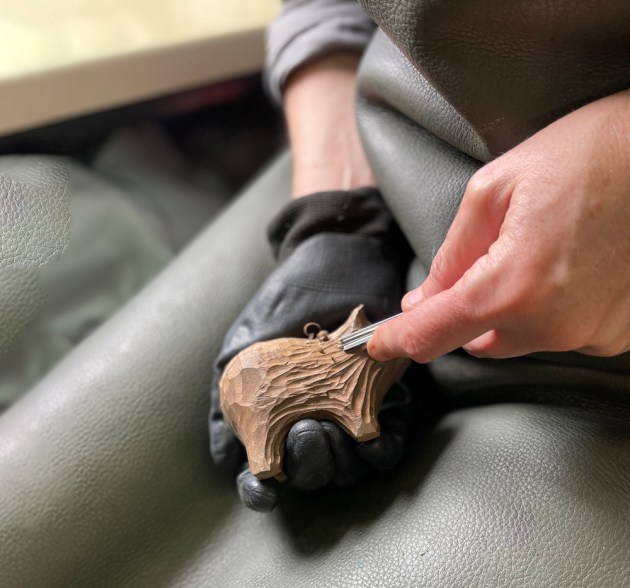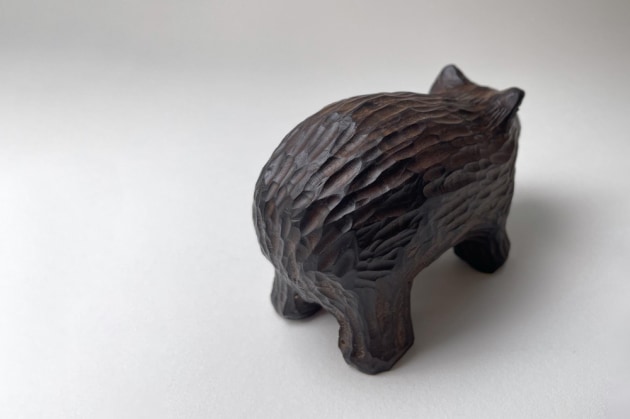Carving animals: In search of company
Words and photos: Carol Russell
I never expected to be spending most of my workshop time carving little animal sculptures. Nevertheless I find myself totally engrossed in the process of trying to capture the sweet and playful nature of animals through the use of simple lines and texture, and only a few hand tools.
At the beginning of 2020, before the world went mad, we were in Japan and had a call from the vet that was caring for our lovely 19 year old cat, Claudia. She’d had a stroke and hadn’t survived. It was so sad to be away from home at the time. A couple of months later our beautiful mini schnauzer Lucy became ill and passed away too.
Completed view of the wombat shown in progress above.
I felt terrible and guilty, and missed them both so much. My response to losing Lucy was to carve a little wooden version of her. I found it comforting to have around – I felt a bit silly but a couple of times people asked to buy it and I absolutely couldn’t part with her. It was a very strong connection I had to this funny little object.
During lockdown that year, I sat at my desk and just carved animals. I didn’t draw them first, just worked in three dimensions and let them evolve. I started really focussing on what aspects of the animals to leave in and what to leave out. I discovered a simple cut in the right place to draw shadow could convey mood and emotion. By not having any pets in the house I had to rely on my imagination and memory, this forced me to really think about what it was about animals that we humans find so endearing.

A small gathering of animals. The Huon pine cat was textured and given a charred finish.
I love looking at the work of craftspeople working in other mediums. In particular, Japanese artist Hideo Sawada is one of my favourites. He carves mostly small figures, both humans and animals. They are full of emotion, yet there is such economy of line; simple facets picking up shadows, almost no detail at all but each piece speaks volumes.
I knew I didn’t want to make my animals too realistic or copy other artists. I wanted to carve them from my own imagination and capture what I thought was the essence of their personality. I started looking at all styles of carving, from very detailed models through to completely gestural, abstract pieces.

The basic process starts with bandsawing a rough blank. You can sketch your design, but then let it develop as you go.

Axes and stock knives can be useful for first roughing out.

Chisels and knives are used in the next stage.
I loved all the vintage wooden toys and wandered through antique shops and revisited my old favourites at the Gallery of Modern Art in Brisbane, the Aurukun camp dogs, so full of fun and mischief. I loved the Scandinavian flat plane carvings too and was very keen to adopt the concept of using knife cut facets to accentuate features and create shadow.
Netsuke also intrigue me, it was the other extreme from what I’d been looking at. These small Japanese carvings are so detailed and expressive, tiny features so well defined, but imbued with so much character. I started looking closely at a netsuke collection in an antique shop near my then-studio in Paddington, Brisbane. Each one told a story it seemed to me.

Pfeil palm chisels are useful – small V-tools work well to create texture on this Huon pine cat.
Whilst driving to Grafton on a teaching trip, I listened to the astounding audio book of The Hare With The Amber Eyes by Edmund De Waal. It’s about a netsuke collection’s intergenerational journey, beginning in 19th century Paris. This book highlighted for me how important objects can be, and how they can even be conduits for storytelling. The act of giving them as gifts can be far-reaching, and mean more than the maker can anticipate.
I had already discovered that a small wooden carved dog or cat could become a companion of sorts. It seemed they could also convey a strong message if given from one person to another. I thought perhaps they may serve as a totem or a familiar that watches over us. Although I didn’t want to become too focused on where a finished piece ended up, it is a consideration for me, the world has a lot of objects in it. I want what I make to mean something to someone as well as me.

Animals on parade. ‘They can take on a life of their own.’
I have some finished work in my workshop, both dogs and cats. Their presence is felt, they sit on the bench watching me quietly, I admit feeling some comfort and occasionally judgement, from them.
I started carving all sorts of animals, pigs, horse, dogs and cats. I watch them whenever I can. I’ve observed dogs in joyful bliss at the smells, sights and sounds of the world as they’re walked on leashes by their owners. I remember walking behind a particularly sweet Welsh terrier one day – he was so full of attitude as he strutted along, that was what I wanted to capture in my work, that chemistry we have with animals that makes them our allies and friends, and cause us to love them.

A heavily textured dog in white beech. ‘Try and have the long grain running through the most fragile parts, tails and legs can easily break if the grain is too short.’
I’ve learned through teaching, that carving or any other creative pursuit isn’t just about the physical process, a lot of the battle is won by having your mind in the right place. If you train your hands well and are very solid in your technique, it’s possible to free up your thoughts so you can spend your energy visualising the subject and not thinking too much about the mechanics of carving.
As my skills improve, there’s a definite moment for me when a piece comes to life. It could be getting the ears right, or the tilt of the head; the subject starts to lift out of the material and become its own entity, I find it thrilling and a bit surprising. The more I practise the stronger this feeling gets.

Blackwood dog, finished. ‘These pieces are made to hold in your hand and rub your fingers over.’
Timber
Choosing the right timber is very important, I favour harder, darker species such as Tasmanian blackwood or tiger myrtle. I spend a lot of time on the finished texture and find these timbers reflect light, giving the hair or fur a luminous quality. I love the heaviness they have as you hold them. I also use a lot of white beech and Huon pine, they’re both beautiful to carve and texture well – they don’t have the benefit of weight in the hand but I still love them.
Tools and technique
I start with a very basic side profile that I draw and cut out on the bandsaw to create a blank. I avoid too much detail and make it at least 40mm thick, preferring to have plenty of material to carve so I can create the curves and shadows I want.
It’s pretty important with these carvings that you try and get the long grain running through the most fragile parts, tails and legs can easily break if the grain is too short, it can be hard to achieve this as one section will always fall on the short grain.

A dog finished in earth pigment and shellac.
I use an axe or my brand new stock knife to narrow the head and remove all the corners. These tools feel a bit wild and random, but you can actually get a lot of control with them. The rest of the carving is done using a knife and a couple of Pfeil palm chisels.
I have a small detail knife and a hook knife made by Peter Von Trott, an Australian toolmaker, and use it to shape areas where the grain is tricky. The curved blade leaves a lovely clean finish and doesn’t dig in. I use a Mora #120 whittling knife a lot too, they are a really good all-purpose knife and very affordable.

A Westie in progress. ‘As my skills improve, there’s a definite moment for me when a piece comes to life.’
Sharpening
Sharpening is key to success, battling a blunt tool will distract and frustrated you. I use a strop every 20 minutes or so and go to a 4000 grit waterstone every hour. If I need abrasiveness to remove more metal, I have 1200 and 2000 grit wet and dry sandpaper on a flat block. Little and often seems to be the best approach to sharpening for me. I use the Pfeil Arkansas slipstones for my palm chisels.
Finishing
With finishing I have a few different approaches. For the heavily textured animals with fur, I use wax. I make a beeswax polish with one part beeswax melted together with three parts flaxseed oil. I apply it with brown paper and burnish it in with a coarse brush; I then buff it with a soft cloth. I repeat this over a couple of days. It will start to build up a real sheen. The more you do it the better it gets.
For the smooth sculptures like the little contemporary netsuke cats, I use shellac and bring it to a high gloss, brushing on three coats, sanding with 800 grit sandpaper between the coats. I then move to a pad or rubber, some cotton wadding wrapped inside a piece of cotton cloth. I charge the wadding with a small amount of shellac and burnish up the surface of the piece, using a drop of linseed oil on the base of the pad if it starts to get sticky. I do this over a couple of days as well, allowing the shellac to set hard. It takes practice, but it’s a beautiful finish and feels lovely. These pieces are made to hold in your hand and rub your fingers over.

A Huon pine textured cat with a charred finish.
Preparation is key, a smooth finish requires meticulous sanding and moving through the grades of sandpaper. Remove all the marks with the coarser paper and only move on to finer grades once you have. The finer grades are used to remove the scratches from the previous grade, not to remove blemishes. It’s slow going, but with a small object your fingers pick up every fault.
I think of these little carvings as play really. I try not to get too serious and let the subject take me where it will, that’s often to a good place but occasionally I produce true shockers. These are the ones I learn the most from, it can be a humbling experience indeed.
Carol Russell is a woodworker and woodcarver now based in Launceston, Tasmania. Learn more at www.carolrussellwoodwork.com.au




